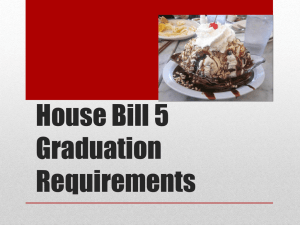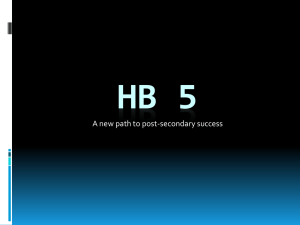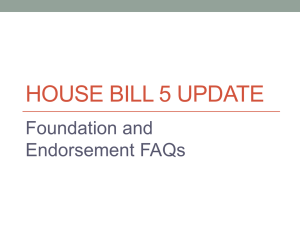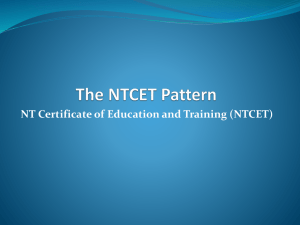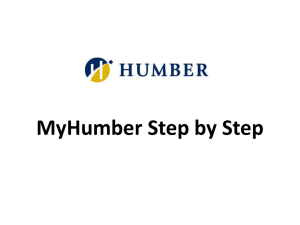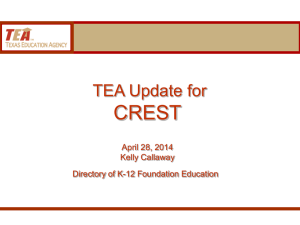HB 5 What we know today!
advertisement
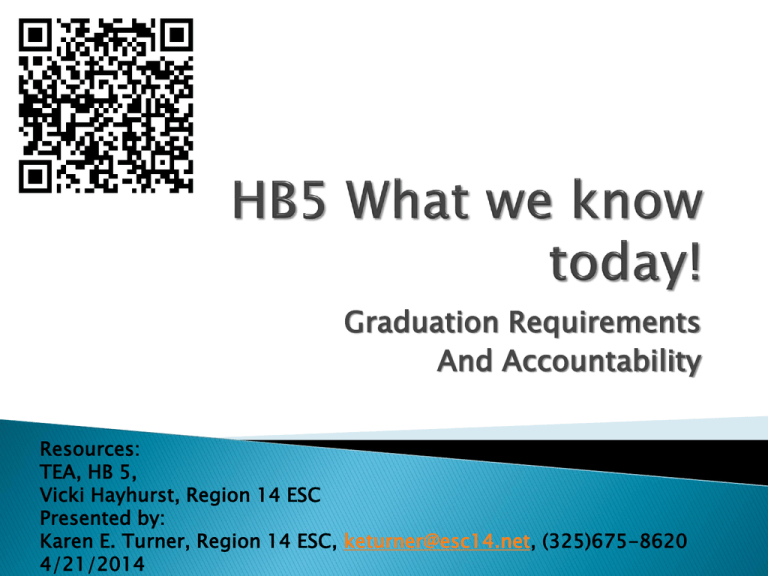
Graduation Requirements And Accountability Resources: TEA, HB 5, Vicki Hayhurst, Region 14 ESC Presented by: Karen E. Turner, Region 14 ESC, keturner@esc14.net, (325)675-8620 4/21/2014 New Graduation Plans ELA Four credits English I English II English III Advanced English Course Mathematics Three Credits Algebra I Geometry Advanced Math Course Science Three Credits Biology IPC or Advanced Science Course Advanced Science Course Social Studies Three Credits U.S. History U.S. Government (one-half credit) Economics (one-half credit) World Geography or World History or Combined World History/World Geography(course not developed yet) Physical Education One credit Languages Other Than English Two credits in the same Language Computer programming language (other exceptions) Fine Arts One Credit Electives Five Credits Any two levels in the same language Two credits in computer programming languages selected from Computer Science I, II, and III (allowable through the 2015-2016 school year) If a student, in completing the first credit of LOTE, demonstrates that the student is unlikely to be able to complete the second credit, the student may substitute another appropriate course as follows: 1) Special Topics in Language and Culture 2) World History Studies or World Geography Studies for a student who is not required to complete both by the local district 3) Computer programming languages 4) A different language course A student who, due to a disability, is unable to complete two LOTE credits in the same language must be allowed to substitute two credits in English language arts, mathematics, science, or social studies or two credits in CTE or technology applications to satisfy the LOTE credit requirements. A specific speech course will not be a requirement under the Foundation HS Program. New Requirement: To receive a high school diploma, a student must demonstrate proficiency, as determined by the district in which the student is enrolled, in: 1) Delivering clear verbal messages 2) Choosing effective nonverbal behaviors 3) Listening for desired results 4) Applying valid critical-thinking and problemsolving processes 5) Identifying, analyzing, developing, and evaluating communication skills needed for professional and social success in interpersonal situations, group interactions, and personal and professional presentations. Documentation of a student’s demonstrated proficiency must be included on the Academic Achievement Record (AAR). School districts have the authority to use Professional Communications to meet the speech requirement. This is a local district decision. A student may earn an endorsement by successfully completing: 1) Curriculum requirements for the endorsement 2) Four credits in math 3) Four credits in science 4) Two additional elective credits Each school district must make available to high school students courses that allow a student to complete the curriculum requirements for at least one endorsement. A school district that offers only one endorsement curriculum must offer the multidisciplinary studies endorsement curriculum. A school district defines advanced courses and determines a coherent sequence of courses for an endorsement area, provided that prerequisites are followed. A course completed as part of the set of four courses needed to satisfy an endorsement requirement may also satisfy a requirement under the Foundation HS Program, including an elective requirement. A student may earn a distinguished level of achievement by successfully completing: A total of four credits in math, which must include Algebra II A total of four credits in science The remaining curriculum requirements The curriculum requirements for at least one endorsement A student must earn distinguished level of achievement to be eligible for top 10% automatic admission. A student may earn a performance acknowledgment: A. For outstanding performance B. In a dual credit course In a bilingualism and biliteracy On an AP test or IB exam On the PSAT, the ACT-Plan, the SAT, or the ACT For earning a nationally or internationally recognized business or industry certification or license A student may earn a performance acknowledgment on the student’s diploma and transcript for outstanding performance in a dual credit course by successfully completing: 1) At least 12 hours of college academic courses, including those taken for dual credit as part of the Texas core curriculum, and advanced technical credit courses, including locally articulated courses, with a grade of the equivalent of 3.0 or higher on a scale of 4.0 or 2) An associate degree while in high school A student may earn a performance acknowledgment in bilingualism and biliteracy by demonstrating proficiency in accordance with local school district grading policy in two or more languages by: 1) Completing all English language arts requirements and maintaining a minimum grade point average (GPA) of the equivalent of 80 on a scale of 100; and 2) Satisfying one of the following: Completion of a minimum of three credits in the same language in a LOTE with a minimum GPA of the equivalent of 80 on a scale of 100; or Demonstrated proficiency in the Texas Essential Knowledge and Skills for Level IV or higher in a LOTE with a minimum GPA of the equivalent of 80 on a scale of 100; or Completion of at least three credits in foundation subject area courses in a LOTE with a minimum GPA of 80 on a scale of 100; or Demonstrated proficiency in one or more LOTEs through one of the following methods: In addition to meeting the requirements to earn a performance acknowledgment in bilingualism and biliteracy, an English language learner must also have: A. Participated in and met the exit criteria for a bilingual or English as a second language (ESL) program; and B. Scored at the Advanced High level on the Texas English Language Proficiency Assessment System (TELPAS) A student may earn a performance acknowledgment on the student’s diploma and transcript for outstanding performance on a College Board advance placement test or International Baccalaureate examination by earning: 1) A score of 3 or above on a College Board advanced placement exam 2) A score of 4 or above on an International Baccalaureate exam A student may earn a performance acknowledgment on the student’s diploma and transcript for outstanding performance on the PSAT, the ACT-Plan, the SAT, or the ACT by: 1) Earning a score on the Preliminary SAT/National Merit Scholarship Qualifying Test (PSAT/NMSQT) that qualifies the student for recognition as a commended scholar or higher by the College Board and National Merit Scholarship Corporation, as part of the National Hispanic Recognition Program (NHRP) of the College Board or as part of the National Achievement Scholarship Program of the National Merit Scholarship Corporation. 2) 2) 2) Achieving the college readiness benchmark score on at least two of the four subject tests on the ACT-PLAN exam Earning a combined critical reading and math score of at least 1250 on the SAT; or Earning a composite score on the ACT exam of 28 (excluding the writing subscore) A student may earn a performance acknowledgment on the student’s diploma and transcript for earning a nationally or internationally recognized business or industry certification or license with: 1) Performance on an examination or series of exams sufficient to obtain a nationally or internationally recognized business or industry certification or 2) Performance on an examination sufficient to obtain a government-required credential to practice a profession Nationally or internationally recognized business or industry certification shall be defined as an industry validated credential that complies with knowledge and skills standards promulgated by a nationally or internationally recognized business, industry, professional, or government entity representing a particular profession or occupation that is issued by or endorsed by: A national or international business, industry, or professional organization A state agency or other government entity or A state-based industry association Certifications or licensures for performance acknowledgments shall: Be age appropriate for high school students Represent a student’s substantial course of study and/or end-of-program knowledge and skills Include an industry recognized exam or series of exams, an industry validated skill test, or demonstrated proficiency through documented, supervised field experience and Represent substantial knowledge and multiple skills needed for successful entry into a highskill occupation Testing Continues to test 1) 2) 3) 4) 5) Mathematics at grades 3-8 Reading at grades 3-8 Writing at grades 4 and 7 Science at grades 5 and 8 Social studies at grade 8 Required to pass for high school graduation 1) 2) 3) 4) 5) English I (reading and writing combined) English II (reading and writing combined) Algebra I Biology U.S. History Requires districts to provide accelerated instruction to students who fail any of the five required STAAR EOC assessments. 1) Allows satisfactory performance on other assessments (e.g., AP, IB, SAT, ACT) in equivalent courses to substitute for performance on STAAR EOC assessments. 2) 3) A 3 on the AP exam A 4 on the IB exam Meeting Texas Success Initiative (TSI) on college readiness benchmarks prescribed by THECB for college preparatory classes under Sec. 28.014. School District Evaluation of Performance in Community and Student Engagement (HB5) 1) Each district must annually evaluate district and campus performance in community and student engagement and assign a performance rating of Exemplary, Recognized, Acceptable, or Unacceptable 2) Required measures to be evaluated a) Fine arts b) Wellness and PE c) Community and parental involvement (such as opportunities for parents to assist students in preparing for assessments, tutoring programs, community service projects for students) d) 21st Century Workforce Development e) Second Language Acquisition f) Dropout Prevention Strategies g) Educational programs for G/T students h) Record of the district and campus in complying with statutory reporting and policy requirements 3) 4) Each school district will use criteria developed by a local committee and will report ratings to TEA and make ratings publicly available by August 8 of each year The school district will report in their June PEIMS submission on all 7 measures and check yes or no if they are complying with statutory reporting and policy requirements. Distinction Designations (HB5) 1) 2) TEA issue district and campus distinction designations with district/campus performance ratings by August 8 of each year (in connection with performance ratings) District and campus distinction designations shall be awarded for outstanding performance in attainment of postsecondary readiness and must include, as newly added factors, the percentage of students who: a) b) c) d) e) Earned a nationally or internationally recognized business or industry certification or license Completed a coherent scope and sequence of CTE courses Completed a dual credit course or an articulated postsecondary course Achieved applicable college readiness benchmarks or the equivalent on PSAT, SAT, ACT or ACT-Plan Received a score on AP or IB assessments sufficient to be awarded college credit College Preparatory Courses (HB5) 1) Each school district is required to partner with at least one IHE to provide courses in college preparatory math and ELA 2) The courses must be designed: a) b) c) d) e) f) g) For students at 12th grade who do not meet college readiness standards on an EOC or whose coursework or college-entrance exams indicate that they are not ready to perform entry-level college coursework; and To prepare students for success in entry-level college courses College preparatory courses must be offered on the high school campus or through DL or an online course Faculty of the high school and IHE must meet regularly to ensure that each course is aligned with college readiness expectations Each school district must provide notice to each student of the benefits of college preparatory courses A student who successfully completes a college preparatory course may use the credit earned toward satisfying the advanced ELA or advanced Math requirement (as applicable) A college preparatory course may be offered for dual credit Accountability 55 HS – N/A MS – 5% Elem – 5% 5% Campuses that earn a Met Standard rating are eligible for 7 campus distinction designations 1. 2. 3. 4. 5. 6. 7. Top 25% Student Progress (Index 2) Academic Achievement in Reading/ELA Academic Achievement in Math Academic Achievement in Science Academic Achievement in Social Studies Postsecondary Readiness for campuses and districts Top 25% Closing Performance Gaps AEA campuses are NOT eligible for distinction designations. A student may graduate under the foundation high school program without earning an endorsement if, after the student’s sophomore year, the student’s parent files with a school counselor written permission, on a form adopted by TEA, allowing the student to graduate under the foundation program without an endorsement (after the student and the student’s parent have been advised by a school counselor of the benefits of graduating with one or more endorsements). Endorsements 1) SBOE rule must provide students with multiple options for earning each endorsement-including coherent sequences of courses, to the greatest extent possible 2) Students must be allowed to enroll in more than one endorsement curriculum prior to their junior year 3) On entering 9th grade each student must indicate in writing an endorsement that the student intends to earn (which may be changed by the student at any time) 4) Each school district must offer at least one endorsement (if only one is offered, it must be Multidisciplinary Studies) District and Campus Ratings to Be Made Publicly Available by August 8 of Each Year 1) Each district shall be assigned a performance rating of A, B, C, D or F (with D or F reflecting unacceptable performance) a) 2) 3) A district may not receive an A if it has any campuses rated Unacceptable Each campus shall be assigned a performance rating of Exemplary, Recognized, Acceptable or Unacceptable Any district or campus with an unacceptable rating for a school year will be notified by June 15 if it is going to be assigned an unacceptable rating for the subsequent year Accountability F A Q http://ritter.tea.state.tx.us/perfreport/account/2013/faq.html Training Packet http://ritter.tea.state.tx.us/perfreport/account/2012/howto.html Accountability Ratings Page http://ritter.tea.state.tx.us/perfreport/account/2013/index.html Notice of Performance Requirements http://ritter.tea.state.tx.us/perfreport/3297_faq.html Accountability Manual http://ritter.tea.state.tx.us/perfreport/account/2013/index.html STAAR Progress Measure Documents http://www.tea.state.tx.us/student.assessment/staar/ Accountability Reports & Information http://ritter.tea.state.tx.us/perfreport/account/2013/index.html Accountability Monitoring Intervention http://www.tea.state.tx.us/index2.aspx?id=2147495563&menu_id=2147483703 Vicki Hayhurst Region 14 ESC https://sites.google.com/a/esc14.net/r14-cte-program-planning/ Karen E. Turner keturner@esc14.net 325-675-8620
